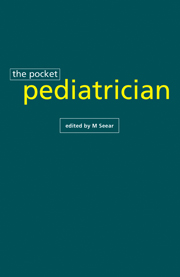Book contents
- Frontmatter
- Contents
- Analytical contents list
- Preface
- 1 Cardiology
- 2 Death and dying
- 3 Emergencies
- 4 Endocrinology
- 5 Fluids and electrolytes
- 6 Gastroenterology
- 7 General surgery
- 8 Health care ethics
- 9 Hematology
- 10 Infectious diseases
- 11 Intensive care and continuous infusion drugs
- 12 Medical genetics
- 13 Neonatology and neonatal drug dosage guidelines
- 14 Neurology
- 15 Nutrition
- 16 Oncology
- 17 Pediatric transport
- 18 Pharmacology and drug dosage guidelines
- 19 Renal
- 20 Resident fellow training
- 21 Respirology
- 22 Rheumatology
- 23 Transfusion medicine
- 24 Appendix
- Index
18 - Pharmacology and drug dosage guidelines
Published online by Cambridge University Press: 01 February 2010
- Frontmatter
- Contents
- Analytical contents list
- Preface
- 1 Cardiology
- 2 Death and dying
- 3 Emergencies
- 4 Endocrinology
- 5 Fluids and electrolytes
- 6 Gastroenterology
- 7 General surgery
- 8 Health care ethics
- 9 Hematology
- 10 Infectious diseases
- 11 Intensive care and continuous infusion drugs
- 12 Medical genetics
- 13 Neonatology and neonatal drug dosage guidelines
- 14 Neurology
- 15 Nutrition
- 16 Oncology
- 17 Pediatric transport
- 18 Pharmacology and drug dosage guidelines
- 19 Renal
- 20 Resident fellow training
- 21 Respirology
- 22 Rheumatology
- 23 Transfusion medicine
- 24 Appendix
- Index
Summary
PEDIATRIC PHARMACOLOGY
The fate of a drug within the body is governed by the pharmacokinetic parameters of absorption, distribution, metabolism and excretion.
Each of these variables changes with age, making rational drug therapy a continual challenge. It is vital to consider drug toxicity, side effects, pharmacokinetics, indications and interactions, and many other variables before giving any medicine to a child. There is no shortage of examples of serious side effects (chloramphenicol, sulfonamide, oxygen toxicity) to illustrate the results of thoughtless “routine” prescribing.
Absorption
Gastric emptying time, intestinal motility, intestinal blood flow and gastric acidity are all poorly developed in infancy. Consequently, enteral absorption is unpredictable and generally slower than it is in adults. Phenytoin and phenobarbital are both absorbed very poorly in children but acid labile drugs may be absorbed better in children than adults.
Topical absorption is much greater in children, especially neonates. Systemic poisoning has been reported after topical application of lindane, hexachlorophene, boric acid and steroid creams.
Distribution
Total body water, especially extracellular water, decreases with age so the loading dose of a water soluble drug like an aminoglycoside will result in a lower peak level in small infants.
Body fat increases with age which affects the fate and toxicity of markedly lipophilic drugs like diazepam and thiopental. Protein binding is decreased in infants due to relative hypoalbuminemia and the lower binding capacity of fetal albumin. Toxicity is possible from increased unbound drug levels. Drug displacement also occurs more easily. Bilirubin displacement by sulfonamides is a classical example.
- Type
- Chapter
- Information
- The Pocket PediatricianThe BC Children's Hospital Manual, pp. 420 - 517Publisher: Cambridge University PressPrint publication year: 1996

